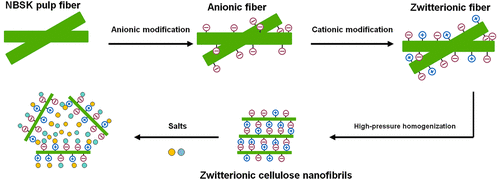当前位置:
X-MOL 学术
›
Biomacromolecules
›
论文详情
Our official English website, www.x-mol.net, welcomes your
feedback! (Note: you will need to create a separate account there.)
Zwitterionic Cellulose Nanofibrils with High Salt Sensitivity and Tolerance.
Biomacromolecules ( IF 5.5 ) Pub Date : 2020-02-18 , DOI: 10.1021/acs.biomac.0c00035 An Wang 1 , Zhaoyang Yuan 2 , Chunping Wang 1 , Langman Luo 1 , Weifeng Zhang 1 , Shao Geng 1 , Jialei Qu 1 , Bing Wei 3 , Yangbing Wen 1
Biomacromolecules ( IF 5.5 ) Pub Date : 2020-02-18 , DOI: 10.1021/acs.biomac.0c00035 An Wang 1 , Zhaoyang Yuan 2 , Chunping Wang 1 , Langman Luo 1 , Weifeng Zhang 1 , Shao Geng 1 , Jialei Qu 1 , Bing Wei 3 , Yangbing Wen 1
Affiliation

|
To improve the salt tolerance/sensitivity of cellulose nanofibrils (CNFs), zwitterionic cellulose nanofibrils (ZCNFs) were prepared from softwood bleached kraft pulp fibers via a sequential process of anionic modification with 2,2,6,6-tetramethylepiperidin-1-oxyl (TEMPO)-mediated oxidation, cationic modification with (2,3-epoxypropyl) trimethylammonium chloride (EPTMAC), and high-pressure homogenization. To produce ZCNFs with different contents of cation group, EPTMAC loadings of 0.15 to 1.15 g/g fiber were explored during cationization. The obtained ZCNFs were characterized by Fourier transform infrared spectroscopy (FT-IR), X-ray photoelectron spectra (XPS), thermogravimetric analysis (TGA), transmission electron microscopy (TEM), and rheological measurements. The salt tolerance of the ZCNFs was investigated by adding mixed salts into the ZCNF dispersions. The results demonstrated that the ZCNFs with both anionic and cationic charges were produced. Compared with the TEMPO-mediated oxidized cellulose nanofibrils (TOCNFs), the ZCNFs exhibited an excellent "salt-thickening" behavior under the studied salt concentrations (2-24% w/w). Moreover, increasing the content of the cation group increased the salt tolerance/sensitivity of ZCNFs. This work demonstrated that introducing cationic charges to the anionic charged TOCNFs imparts the produced ZCNFs with excellent salt sensitivity and tolerance, which could expand the application of nanocellulose in oil recovery or wastewater treatment.
中文翻译:

具有高盐敏感性和耐受性的两性离子纤维素纳米原纤维。
为了提高纤维素纳米原纤维(CNF)的耐盐性/敏感性,两性离子型纤维素纳米原纤维(ZCNF)是由软木漂白的牛皮纸浆纤维经2,2,6,6-四甲基哌啶-1-氧基(3,3,3,3,3,4,5-三氯乙烷)的阴离子改性顺序制备的( TEMPO)介导的氧化,用(2,3-环氧丙基)三甲基氯化铵(EPTMAC)进行阳离子改性以及高压均质化。为了生产具有不同阳离子基团含量的ZCNF,在阳离子化过程中探索了EPTMAC负载量为0.15至1.15 g / g纤维。通过傅立叶变换红外光谱(FT-IR),X射线光电子能谱(XPS),热重分析(TGA),透射电子显微镜(TEM)和流变学测量来表征获得的ZCNF。通过将混合盐添加到ZCNF分散液中来研究ZCNF的耐盐性。结果表明,制备了具有阴离子和阳离子电荷的ZCNF。与TEMPO介导的氧化纤维素纳米纤维(TOCNFs)相比,在所研究的盐浓度(2-24%w / w)下,ZCNFs表现出优异的“盐增稠”行为。而且,增加阳离子基团的含量增加了ZCNF的盐耐受性/敏感性。这项工作表明,将阳离子电荷引入阴离子带电荷的TOCNFs可使制得的ZCNF具有出色的盐敏感性和耐受性,这可以扩大纳米纤维素在采油或废水处理中的应用。与TEMPO介导的氧化纤维素纳米纤维(TOCNFs)相比,在所研究的盐浓度(2-24%w / w)下,ZCNFs表现出优异的“盐增稠”行为。而且,增加阳离子基团的含量增加了ZCNF的盐耐受性/敏感性。这项工作表明,将阳离子电荷引入阴离子带电荷的TOCNFs可使制得的ZCNF具有出色的盐敏感性和耐受性,这可以扩大纳米纤维素在采油或废水处理中的应用。与TEMPO介导的氧化纤维素纳米纤维(TOCNFs)相比,在所研究的盐浓度(2-24%w / w)下,ZCNFs表现出优异的“盐增稠”行为。而且,增加阳离子基团的含量增加了ZCNF的盐耐受性/敏感性。这项工作表明,将阳离子电荷引入阴离子带电荷的TOCNFs可使制得的ZCNF具有出色的盐敏感性和耐受性,这可以扩大纳米纤维素在采油或废水处理中的应用。
更新日期:2020-02-18
中文翻译:

具有高盐敏感性和耐受性的两性离子纤维素纳米原纤维。
为了提高纤维素纳米原纤维(CNF)的耐盐性/敏感性,两性离子型纤维素纳米原纤维(ZCNF)是由软木漂白的牛皮纸浆纤维经2,2,6,6-四甲基哌啶-1-氧基(3,3,3,3,3,4,5-三氯乙烷)的阴离子改性顺序制备的( TEMPO)介导的氧化,用(2,3-环氧丙基)三甲基氯化铵(EPTMAC)进行阳离子改性以及高压均质化。为了生产具有不同阳离子基团含量的ZCNF,在阳离子化过程中探索了EPTMAC负载量为0.15至1.15 g / g纤维。通过傅立叶变换红外光谱(FT-IR),X射线光电子能谱(XPS),热重分析(TGA),透射电子显微镜(TEM)和流变学测量来表征获得的ZCNF。通过将混合盐添加到ZCNF分散液中来研究ZCNF的耐盐性。结果表明,制备了具有阴离子和阳离子电荷的ZCNF。与TEMPO介导的氧化纤维素纳米纤维(TOCNFs)相比,在所研究的盐浓度(2-24%w / w)下,ZCNFs表现出优异的“盐增稠”行为。而且,增加阳离子基团的含量增加了ZCNF的盐耐受性/敏感性。这项工作表明,将阳离子电荷引入阴离子带电荷的TOCNFs可使制得的ZCNF具有出色的盐敏感性和耐受性,这可以扩大纳米纤维素在采油或废水处理中的应用。与TEMPO介导的氧化纤维素纳米纤维(TOCNFs)相比,在所研究的盐浓度(2-24%w / w)下,ZCNFs表现出优异的“盐增稠”行为。而且,增加阳离子基团的含量增加了ZCNF的盐耐受性/敏感性。这项工作表明,将阳离子电荷引入阴离子带电荷的TOCNFs可使制得的ZCNF具有出色的盐敏感性和耐受性,这可以扩大纳米纤维素在采油或废水处理中的应用。与TEMPO介导的氧化纤维素纳米纤维(TOCNFs)相比,在所研究的盐浓度(2-24%w / w)下,ZCNFs表现出优异的“盐增稠”行为。而且,增加阳离子基团的含量增加了ZCNF的盐耐受性/敏感性。这项工作表明,将阳离子电荷引入阴离子带电荷的TOCNFs可使制得的ZCNF具有出色的盐敏感性和耐受性,这可以扩大纳米纤维素在采油或废水处理中的应用。











































 京公网安备 11010802027423号
京公网安备 11010802027423号